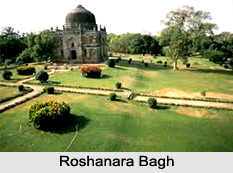 Roshanara Bagh is now a tourist destination in Delhi, the capital of India and it is a garden built by the Mughal Dynasty during their rule in India.
Roshanara Bagh is now a tourist destination in Delhi, the capital of India and it is a garden built by the Mughal Dynasty during their rule in India.
Formation of Roshanara Bagh
Roshanara Bagh is a Mughal-style garden built by Roshanara Begum, the second daughter of the Mughal emperor Shah Jahan.
Location of Roshanara Bagh
Roshanara Bagh is situated in Shakti Nagar near Kamla Nagar Clock Tower and North Campus of University of Delhi.
History of Roshanara Bagh
Roshanara Bagh has a raised canal with flowering plants on both sides. Today the garden holds a white marble pavilion built in memory of the princess Roshanara, who died in 1671 and was buried there. Back in those times, it was surrounded by a thick forest, but now it`s more like an oasis amidst a concrete jungle. The ruins of her palace and tomb can also be found in one corner of the garden, complete with a long canal that must have watered the gardens on both sides during its heyday. But as of now, this entire monument is in ruins while the rest of the garden is in a much better shape. The elite Roshanara Club which was started here in 1922 by the British Empire in India is spread over 22 acres. Since 1927 first class cricket is played at the Roshanara Club Ground, which now boasts floodlights.
Birthplace of Board of Control for Cricket in India
Roshanara Bagh is considered the birthplace of the Board of Control for Cricket in India (BCCI). The post independence cricket administrators gathered in front of an old fireplace and sowed the seeds of the Indian cricket body.
Garden in Roshanara Bagh
Roshanara Bagh is one of the biggest gardens in Delhi having a great variety of plants, some imported from Japan. The lake inside the gardens is visited by migratory birds during winters and is a popular site for bird watching.
Visiting Information
Roshanara Bagh is serviced by the Pul Bangash metro station on the Red Line of Delhi Metro. Roshanara Bagh is situated close to National Highway 1 on the Grand Trunk Road.
Related Articles
Medieval History of India
Islamic Architecture
Mughal Architecture
Gardens in Mughal Architecture
Culture of Jammu and Kashmir
Jammu and Kashmir, Indian State
Costumes of Jammu and Kashmir



















